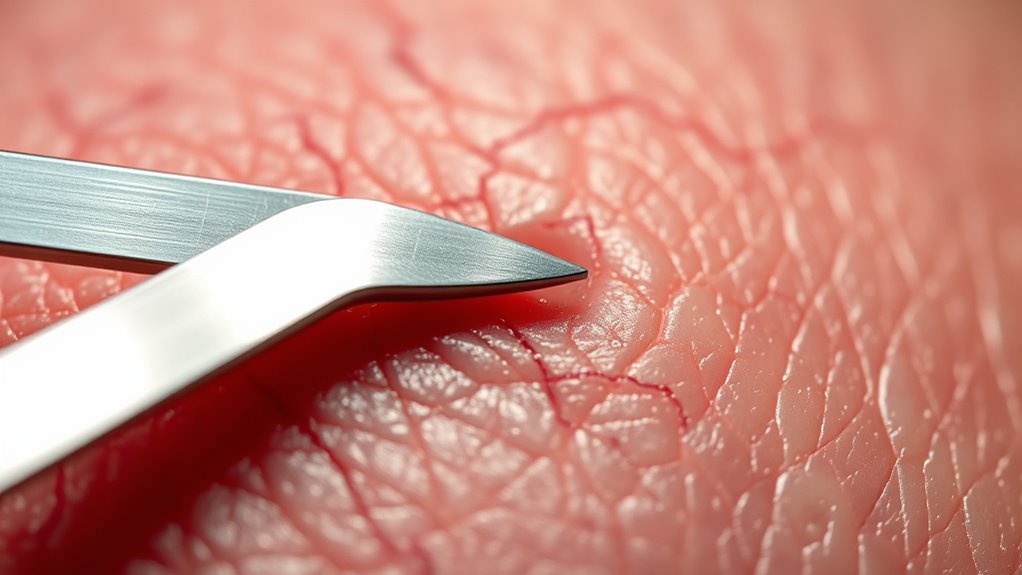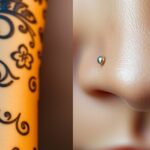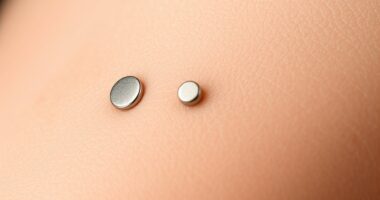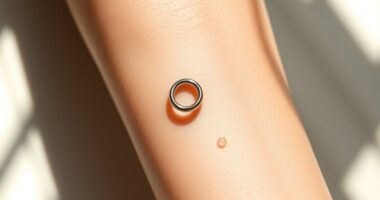Scalpel piercing is a precise body modification procedure that involves making controlled incisions with a surgical blade professional, not DIY. Only experienced practitioners with specialized training attempt it because it requires strict safety measures, sterile environments, and detailed knowledge of anatomy to prevent risks like infections, nerve damage, or scarring. Due to its complexity, this technique is best left to experts—continue exploring to discover more about its history and safety practices.
Key Takeaways
- Scalpel piercing involves making precise incisions with a sterile surgical blade to create body modifications.
- Only trained professionals perform it due to its complexity, risk of nerve damage, and need for sterile technique.
- Proper safety measures, such as sterilization and anatomical knowledge, are essential to prevent infections and complications.
- The procedure’s risks include bleeding, scarring, and tissue trauma, requiring expert handling and aftercare.
- Its complexity and potential dangers make it a task reserved for experienced practitioners with specialized training.

Have you ever considered scalpel piercing as a safe alternative to traditional body modifications? This technique, though relatively new in the domain of body art, has roots that trace back to ancient practices of body modification. Historically, body modification has been part of many cultures worldwide, serving as rites of passage, symbols of status, or spiritual markers. Over centuries, methods evolved from primitive tools to more sophisticated devices, but safety was often a concern. Today, the modern approach to body modification, especially with scalpel piercing, emphasizes strict safety precautions. These precautions are essential because, unlike typical piercings done with needles, scalpel piercing involves making precise incisions using surgical blades, which can carry higher risks if not handled correctly.
Understanding the history of body modification helps you appreciate why safety precautions are so essential today. In traditional practices, the lack of sterile environments and proper tools often led to infections or complications. Modern techniques, however, have been refined to minimize these risks. When it comes to scalpel piercing, only trained professionals with extensive knowledge of anatomy and sterilization procedures should attempt it. They follow rigorous safety protocols, including using sterilized scalpels, gloves, and sterile environments to prevent infections. They also meticulously plan each piercing, considering the anatomy and unique features of your body to avoid nerve damage or other complications.
Modern scalpels, sterile environments, and expert planning make scalpel piercing a safe, precise body modification technique.
Safety precautions aren’t just about avoiding infections; they also involve understanding the specific risks associated with scalpel piercing. For example, because it involves incisions rather than simple punctures, there’s a greater chance of bleeding and tissue trauma if not performed correctly. That’s why only experienced artists, who have undergone specialized training, should attempt these piercings. They know how to handle the tools carefully, control bleeding, and provide proper aftercare instructions. Skipping this step or attempting it yourself can lead to serious health issues, including scarring or infections, which is why only experts are qualified for such procedures.
In short, the history of body modification shows a progression toward safer, more refined techniques, but it also highlights the importance of safety precautions. Scalpel piercing is a prime example of how advanced methods require an expert’s touch. When performed by a trained professional, it can be a safe, artistic form of self-expression. However, the complexity and potential risks involved mean you should always seek out qualified practitioners who prioritize hygiene, precise technique, and your overall health. Understanding the evolution of techniques and strict safety standards surrounding body modification helps you make informed decisions and appreciate why only experienced professionals should attempt scalpel piercing.
Frequently Asked Questions
How Long Does Scalpel Piercing Healing Typically Take?
The healing timeline for a scalpel piercing varies depending on the placement, your body’s healing ability, and aftercare. Typically, it takes about 4 to 8 weeks for initial healing, but deep tissue or cartilage piercings may take longer. The scalpel technique, performed by experts, minimizes trauma and promotes faster healing. Follow your piercer’s aftercare instructions carefully to guarantee proper healing and reduce the risk of complications.
Are There Specific Risks Associated With Scalpel Piercing?
You should know that scalpel piercing carries specific risks, like infection risks and nerve damage. Because it’s a precise procedure, if not done correctly, you might face serious complications, including nerve injury or infection that could require medical intervention. Only trained professionals have the skills to minimize these risks, ensuring your safety. Avoid attempting this at home, and always choose an experienced expert for such procedures.
Can Scalpel Piercing Be Done on All Skin Types?
You might wonder if scalpel piercing works on all skin types. It’s important to take into account skin type considerations, as some skin may react differently or be more prone to scarring or infection. Your healing process can also vary based on skin type, with some needing extra care. Always consult a professional to assess your skin and determine if scalpel piercing is suitable for you to ensure safe, effective results.
What Aftercare Is Required Post-Scalpel Piercing?
After a scalpel piercing, you need to follow proper aftercare to prevent infection and minimize scar tissue formation. Keep the area clean with gentle saline washes, avoid touching it with dirty hands, and steer clear of irritants. Apply an antibiotic ointment if recommended, and avoid submerging the piercing in water. Protect it from trauma, and monitor for signs of infection, seeking professional help if needed.
How Does Scalpel Piercing Compare to Traditional Piercing Methods?
Imagine a piercing so precise it feels like sculpting with a razor’s edge. Scalpel piercing uses advanced sterilization techniques and specialized piercing instruments that differ vastly from traditional needles, ensuring unmatched accuracy. While traditional methods rely on standard needles, scalpel piercing offers a cleaner, more controlled process. Only experts handle it, because the risks of improper technique outweigh the benefits, making it a cutting-edge choice for those seeking perfection.
Conclusion
Just like a master artist wields their brush with purpose, only those with skill and precision should attempt scalpel piercing. Remember the cautionary tales of Da Vinci’s daring projects—beauty and danger often dance hand in hand. If you’re tempted to explore this risky art, respect its power and leave it to the experts. After all, some lines are better left uncrossed, lest you find yourself lost in a labyrinth of regret.
I’m Gillian. I love piercings and tattoos- there’s something about the way they make your body look that just makes me happy. I started this blog to share my passion for piercings and tattoos with the world and to help people who are thinking of getting their first piercing or tattoo.
I’ve been writing about piercings and tattoos for a while now on piercings-body.com. I love sharing my knowledge with others and helping people make informed decisions about their bodies.

















